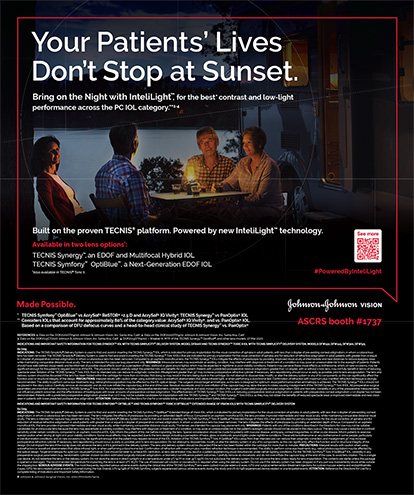Conducting clinical research for devices in the ophthalmic space is quite different from running a traditional practice. There are contracts, recruiting strategies, informed consents, protocols, regulatory documents, data management strategies, investigational devices with stringent guidelines on usage, and much more to consider. This month's column runs through some key considerations for including clinical trials at your practice and how to ensure that your site is set up to run an efficient device study.
GETTING STARTED
On top of your regular practice duties, as the principal investigator of a trial, you will also be supervising the conduct of the study and protecting the rights, safety, and welfare of the enrolled subjects. Prior to agreeing to undertake a clinical trial, and certainly before the trial begins, you and your study staff should enroll in some basic introductory courses on the principles and practices of clinical research. Online courses and/or webinars are viable options for staff who are unable to attend classroom courses. Training should include sessions on good clinical practices. The Collaborative Institutional Training Initiative program offers research ethics education and is the primary training for good clinical practices (www.citiprogram.org). Biannual training such as the Protecting Human Research Participants course offered by the National Institute of Health, which highlights the obligations of those conducting clinical research to protect the rights and welfare of study subjects, should also be a regular component of staff education (phrp.nihtraining.com).
ADAPTING YOUR PRACTICE
You will likely need to reconsider the physical layout of your center when adding clinical trials to your practice. Every study is different, so the requirements and changes to the layout will vary depending on the investigational device. Almost every study sponsor will require that the investigational device be stored in a limited-access location. Proper storage conditions should address the temperature, light, moisture, ventilation, and sanitation needs of the study product. If applicable, a manual log and/or automated recording of key environmental conditions should be kept to document that the required conditions were maintained during the entirety of the study. Medical records and subject case report form books should also have dedicated storage. It may also be beneficial to store study-specific regulatory files, other study-related documentation, and research data.
As you consider your practice's capability to host a clinical trial, it is important to recognize that some devices may take up a considerable amount of space. Also, ensure that your existing equipment is controlled, calibrated, and qualified. Be sure to keep documentation that shows the equipment is properly maintained and functioning correctly.
A study's sponsor will typically inspect a study site before it is approved for the study and again immediately prior to the study's start. Although it may seem obvious, it will be important that you ensure your practice is well maintained. Areas and examination rooms where the study participants will be seen should be clean, accommodating, and well organized. Monitoring visits are also fairly frequent as the study is being conducted, so if your practice has the space, it may be beneficial to set aside a space for monitors to claim as their own.
TIME AND STAFF
Many first-time principal investigators underestimate the amount of time it takes to properly manage a clinical trial. It may not take more time to treat study subjects than it does patients, but the amount of time spent on administrative duties associated with a trial is significant. Having a dedicated study coordinator can take some of the burden off and allow you to focus more intently on the study subjects. Often, the study coordinator is a technician or other staff member from the practice who is ready for a shift in career trajectories or one who is interested in having more responsibility. Your study coordinator can grow in his or her new role as your practice grows and takes on additional studies. The study coordinator can then supervise and oversee some of the administrative functions (recruiting, scheduling, screening, follow-up, data integrity).
STUDY LOGISTICS AND FIRST SUBJECT PREPARATION
For trials involving nonsignificant-risk devices (generally class I/II devices), an investigational device user manual will need to be on hand as well as any device-specific training files and/or records. For studies of significant-risk devices (investigational device exemption required, generally class III devices), be sure that all site staff have reviewed the protocol and the report of prior investigations on the investigational device. For any device class, the sponsor should indicate what level technician is needed so your site knows whether a nurse is sufficient or if a certified ophthalmic technician is necessary.
Once the investigational device has arrived and is stored properly, study subjects have been scheduled, and the protocol has been reviewed, many sites will hold a “kick-off” meeting prior to the study's start so that the staff has a chance to ask questions. This is a good time for you to delegate tasks and sign off on responsibilities. Some sites may opt to run a mock visit with a staff member to troubleshoot any study flow challenges. Additionally, ensure that all equipment is in working order prior to the visit. This is especially important when the investigational device is an imaging system.
When it comes to your first study subject, simple steps can be taken to avert troubling situations and help the visit run smoothly. Placing quick-reference guides in the research space is a useful way to have the critical elements of the study's design handy. Laminating these manuals and placing them in visible locations for staff shows initiative and attention to detail, traits especially important to the sponsor. These guides may be device-use instructions (eg, instructions for the fitting and use of a contact lens), key inclusion/exclusion criteria, schedules of procedures for study visits, etc. Having these compact reference guides will pay off. Also be sure that you have the name and numbers of the clinical research organization or study sponsor contacts for questions to which you may not be able to find the answer. If your site staff needs support, managing parties have the resources readily available to assist, so do not be afraid to ask.
What is a study without any subjects? Placing reminder telephone calls to study subjects a few days in advance of their visit not only gives them a reminder, but it may also be comforting in the event that they are feeling some uneasiness about the trial. By calling, you will build a rapport with the subjects, and if they have any concerns or questions, you can address them at that time. This will also give you a chance to learn of any late-breaking scheduling or transportation conflicts that may have come up since your last conversation. At the very least, be sure to send some form of a reminder, whether it be a mailed letter or e-mail message.
CONCLUSION
Communication and proper preparation in terms of staff, the physical needs of a trial, and prestudy considerations are all necessary components for a successful investigational device trial. Know that implementing clinical trials in your practice is going to involve additional work but that the benefits can be bountiful. n
Section Editor Ryan Bouchard
• director of medical devices at Ora
• (978) 332-9574; bouchard@oraclinical.com; Twitter @oraclinical


